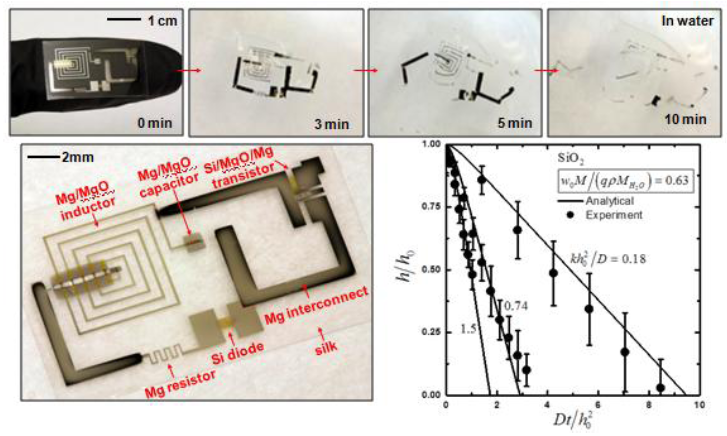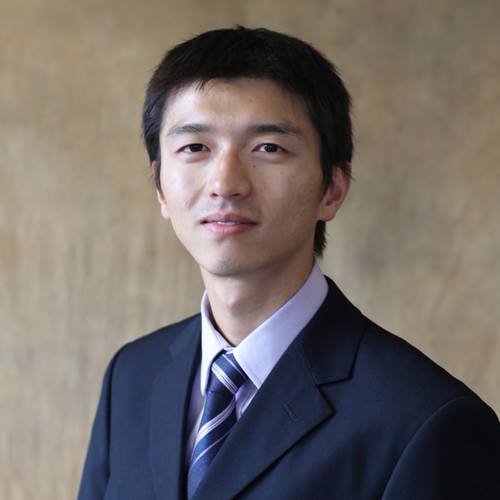Wearable electronics that dissolve in your body
ABASTRACT: Recent advances in electronics enable powerful biomedical devices that have greatly reduced therapeutic risks by monitoring vital physiological signals and providing means of treatment. Better understanding of many unknown diseases could be achieved if implantable devices could be exploited for monitoring. However, an expensive second surgical operation would be needed to remove the devices after an initial implantation. In addition, conventional electronics require components to be formed on planar surfaces of brittle wafer substrates, which is not compatible with the complex topology of body tissues. Therefore, stretchability and resorbability are the two missing links to realize implantable monitors and in-vivo therapeutics. To address these challenges, I propose to design a stretchable medical device that can (a) conform to a complex topology of human organs and (b) function during its lifetime and then completely resorb after use. Implanted devices will provide a much better understanding of how each organ functions and offer more timely treatments for serious diseases such as heart failure.

Figure Demonstration platform for transient electronics, with key materials and device structures. Lower right penal shows experimental and analytical results of SiO2 thickness change as a function of time.
 Biography: Mr. Huanyu Cheng is currently a visiting scholar working with Prof. John A. Rogers in the Department of Materials Science and Engineering at University of Illinois at Urbana-Champaign. He is also a Ph.D. candidate working with Prof. Yonggang Huang in the Department of Mechanical Engineering at Northwestern University. He received his Bachelor degree from Tsinghua University in 2010 and Master degree from Northwestern University in 2011. Mr. Cheng’s research focuses on electronics that dissolve in our body with biologically inspired applications in robotics, biomedicine, and energy. He has authored/co-authored 39 papers in leading archival journals. Mr. Cheng’s recent awards include Howard Hughes Medical Institute International Student Research Fellow (42 recipients in the US), International Institute for Nanotechnology Outstanding Researcher Award (12 recipients in the US), Chinese government award for outstanding self-financed students abroad (489 awardees worldwide), Haythornthwaite Foundation Travel Awards in both 2012 and 2013 (20 awardees in the US), Student Presentation Award at SES, NSF travel grant at ASME-IMECE in both 2012 and 2013(45 awardees in the US), and a few fellowships at Northwestern University including Presidential Fellowship Finalist, Engineering and Health Center Fellowship, Martin Outstanding Graduate Fellowship, Predictive Science and Engineering Design Cluster Fellowship and Walter P. Murphy Fellowship. His research on dissolvable electronics was on display at the “The Museum of Science” in Boston Massachusetts (2012) and it has also been featured in over hundreds of international news outlets, including Science, Nature, BBC, Forbes, Discovery and NSF.
Biography: Mr. Huanyu Cheng is currently a visiting scholar working with Prof. John A. Rogers in the Department of Materials Science and Engineering at University of Illinois at Urbana-Champaign. He is also a Ph.D. candidate working with Prof. Yonggang Huang in the Department of Mechanical Engineering at Northwestern University. He received his Bachelor degree from Tsinghua University in 2010 and Master degree from Northwestern University in 2011. Mr. Cheng’s research focuses on electronics that dissolve in our body with biologically inspired applications in robotics, biomedicine, and energy. He has authored/co-authored 39 papers in leading archival journals. Mr. Cheng’s recent awards include Howard Hughes Medical Institute International Student Research Fellow (42 recipients in the US), International Institute for Nanotechnology Outstanding Researcher Award (12 recipients in the US), Chinese government award for outstanding self-financed students abroad (489 awardees worldwide), Haythornthwaite Foundation Travel Awards in both 2012 and 2013 (20 awardees in the US), Student Presentation Award at SES, NSF travel grant at ASME-IMECE in both 2012 and 2013(45 awardees in the US), and a few fellowships at Northwestern University including Presidential Fellowship Finalist, Engineering and Health Center Fellowship, Martin Outstanding Graduate Fellowship, Predictive Science and Engineering Design Cluster Fellowship and Walter P. Murphy Fellowship. His research on dissolvable electronics was on display at the “The Museum of Science” in Boston Massachusetts (2012) and it has also been featured in over hundreds of international news outlets, including Science, Nature, BBC, Forbes, Discovery and NSF.

